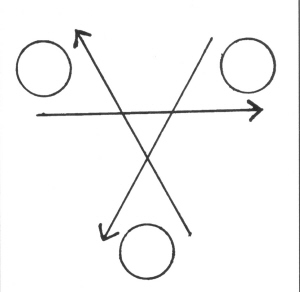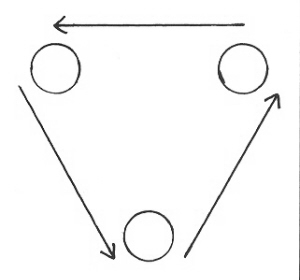|
Juggler's
Workshop
Uncommon
Passing
BY MARTIN FROST
This
time we'll describe some good but uncommon club passing
variations. These include various triangles, some extensions
to Bruno's Nightmare and some interesting pass-passself
patterns.
The
Triangle
The
triangle is a pattern that all club passers should know. The
basic triangle isn't too difficult, but it can be extended to
make it more challenging for experienced passers.
There
are two types of passes you can make in a triangle: the inside
pass and the outside pass. An inside pass goes through the
middle of the triangle, whereas an outside pass goes along the
border of the triangle. You're making an inside pass if you throw
right handed to the person on your left or left handed to the
person on your right. It's an outside pass if you throw right
handed to the person on your right or left handed to the
person on your left. Fig. 1 shows an inside triangle, and Fig.
2 an outside triangle.
The
inside triangle is a little easier than the outside triangle
because you don't have to look so far back and forth to see
both the hand you're throwing to and the hand you're catching
from.
To
learn these patterns, form an equilateral triangle, with each
juggler having three clubs. It's important to make the three
sides of the triangle equal or one of you will be looking back
and forth with difficulty over a larger angle.
Start
by passing a 4-count (every other), with everyone passing at
the same time. This gives you time to recover between
imperfect passes. Each juggler always passes to the same
person (Fig. 1 or 2).
You
should also try a 3-count (or a 5count) if you all have some
experience with left-handed passing. Remember that in a
3-count, including the triangle, you immediately pass back
each pass that you catch.
This allows you to keep three clubs going back and forth on
the inside (or outside) of the triangle.
With
an inside triangle, a common mistake is making short or inside
passes. The passes have to be a little longer than you might
think because your partner is, on average, facing the middle
of the triangle, not you. That means that the hand that will
catch an inside pass is further from you than the hand that
would catch an outside pass. So make those inside passes long.
Also keep your inside passes wide to avoid cutting across the
space where your partner's self is thrown, where a collision
in front of the face could be painful.
In
the outside triangle, try to make throws that go just outside
the shoulder of the receiver, so that an ignored club will not
hit your partner. These passes need to be a little shorter
since the outside hand is a little closer to you than the
inside hand.
In
any pattern where you are always throwing to one person but
catching from another, including the basic triangle, the
following hint can be helpful: Position your body to face the
person you're throwing to and turn only your head to see clubs
coming from your other partner. This will help your passes
to go to the right place, since you can pass pretty much
straight ahead from your base body position. Nevertheless,
when you're about to pass, take a quick glance where you want
the club to go to reinforce your aim. Look at the spot in the
air just outside your partner's shoulder, since that's where
the club should go.
2-Count
Pass-Pass-Self Triangle
In
this pattern, instead of all three jugglers passing at the
same time, two at a time exchange clubs. First one pair
exchanges clubs, while the third person does a self, then a
second pair exchanges on the second beat, and finally the
third pair exchanges on the third beat.
The
result is that each juggler's right hand does: pass, pass,
self. On each beat, two jugglers on one of the triangle's
three sides are passing to each other while the third does a
self. The passing leg of the triangle moves around the
triangle either clockwise or counter-clockwise - take your
pick.
Instead
of doing pass-pass-self in a 2count, try it in a 3-count, to
get your left hand in on the action. This means your sequence
(every third count) will be: right-inside-pass, left-insidepass,
right-self, left-outside-pass, right-outside-pass, left-self
(each person starts at a different right-hand point in this
sequence). Thus everyone does both inside and outside passes
from both hands.
Hovey's
Nightmare
If
we do a pass-pass-self triangle in a 1-count (instead of the
above 2-count or 3-count), we get Hovey's Nightmare, named
after Hovey Burgess. Here each person is doing the same thing
as the feeder in a 3-count feed, but the three are out of
phase. The first two jugglers exchange rights, then the second
pair exchanges lefts, then finally the third pair exchanges
rights. Then you're back to the start to repeat with opposite
hands.
The
60-degree angle here, and the fact that everyone is doing a
feed, combine to make this somewhat harder than the 3-count
feed. So make sure each of you can feed a 3-count feed before
trying Hovey's Nightmare. Remember that the sequence in both
the 3count feed and Hovey's Nightmare is the same as that
shown just above - inside, inside, self, outside, outside,
self - with three different starting points (inside, self and
outside) for the three jugglers.
1-Count
Inside-Outside Triangle
A
real challenge in triangles is the I-count inside-outside
triangle. In this pattern, all three jugglers are doing the
same thing at the same time, and the pattern is simple to
describe. Each juggler passes this sequence (counting both
hands): inside, inside, outside, outside. There are no
selves, but to work up to this, try adding two selves (right,
left) after each pair of passes (pass, pass, self, self). Keep
those inside passes long and wide, the outside passes shorter
and outside, and try to glance at each target spot just
before each pass. Keep all the passes high and a little lofty.
|



